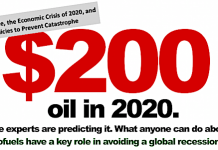The recent slump in the price of energy commodities that has accompanied slumps in the rest of the market has reignited an old debate: to what extent is the performance of alt energy companies (and their stock prices) linked to fossil energy prices? People who argue that the two are closely connected implicitly believe that policy-makers and other important economic actors view alt energy mainly as a hedge against high energy prices, and therefore believe that a drop in fossil energy costs will result in a fall from grace for alt energy (there is evidence that at least some firms view renewable energy as such, providing credence to this argument). Those who, like myself, believe that the fundamental performance of firms in the sector is not connected to the price of fossil energy (considerations of input costs aside), argue that the policy commitment behind the growth of much of renewable energy for the past few years has had more to do with political positioning on the increasingly-salient environment file.
In a simpler follow-up to an article I wrote in July, I decided to put together a chart looking at the performances of a few ETFs since early July, when the commodity bubble burst. I included the following: (a) the S&P 500, as a general benchmark of performance for equity markets; (b) the USO ETF, which tracks the price of crude oil; (c) the UNG ETF, which tracks the price of natural gas; (d) the PWND ETF, which I believe provides more direct exposure to the wind sector than does the other wind ETF, FAN; and (e) the KWT ETF for solar, for no particular reason. Tom wrote a useful article on alternative energy and cleantech ETFs and mutual funds in July, for those who missed it. I apologize for the quality and look of the graph – I picked the background that made it easiest to see the lines, and BigCharts doesn’t exactly allow you to produce nice, clean charts.

If we accept that current stock prices reflect expectations of future firm performance, looking at this chart certainly seems to indicate that investors believe the outlook for the wind and solar sectors is grim. Indeed, not only have wind and solar stocks fallen much further than the market as a whole (>30% for solar!), but investors have discounted them beyond the fundamental risk they see in falling fossil energy prices. This outcome is broadly in line with the efficient market hypothesis – alt energy outperformed the market as a whole over the past couple of years because alt energy investors took greater risks.
For the solar sector, this drop can be explained by concerns over a perfect storm brewing over the industry in 2009, coupled with uncertainty over the sustainability of very generous subsidy regimes in key markets like Spain and Germany. For wind, which relies for its deployment on project finance-type of arrangements with high gearing ratios, concerns over rising debt costs have added to anxiety about declining natural gas prices, wind’s main economic competitor in the US.
In light of this, what’s the answer to the main question posed initially about the relations to fossil energy prices? It’s not clear. It is still too early to draw conclusions about any clear relationship between the performance of solar and wind firms and the prices of oil and natural gas. It is also impossible at this stage to disentangle all of the headwinds facing solar and wind and assert that energy prices play a larger role than other factors. In my view, if policy commitments to alternative energy are strengthened rather than weakened during this crisis, which looks like it might be the case, it would represent the clearest evidence yet that policy-makers pay little to no attention to energy prices in deciding on support measures for the sector. In any event, what policy-makers believe may not matter much of the IEA is right about global oil supplies. In either case, alt energy investors win.
DISCLOSURE: Charles Morand does not have a position in any of the securities listed here.







The pullback by Pickens on his plan, and his comments on Larry King Live recently, seem to confirm the conclusion.
It may be a bit theoretical, and maybe a long way off, but eventually couldn’t the sunken cost of oil and its negative long-term effects on the environment play into the price of oil? As a world we must begin to develop a sense of urgency about this situation that is taking place. Given the changing of the guard in the White House and the commitment to alternative energy by the new regime I believe its the best time to buy into alternative energy. Granted, you may have to wait a few years for your returns, but given the dire need to lessen fossil fuel usage in our daily lives, it is an absolute that clean renewable energy will continue to grow.